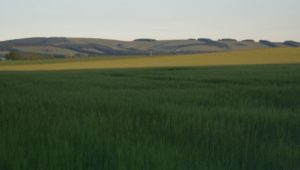Planning ahead for sustainable plant health
12 November 2018Strategic forward planning to minimise plant health risks on farm might be an impossible ask in the main field season and the fast paced harvest and drilling period we’ve just come through, but now we have more enforced office days watching rain run down the windows, what better thing to ponder than plant health? Why not dig out field spray records and compare with the yields achieved? How happy were you with the efficacy of spray programmes and what were your main pest, disease and weed issues? It is all too easy to plunge into another season with a same again approach or to hand over all the responsibility of spray programmes to your agronomist.

Testing of new barley varieties with improved disease resistance is one aspect of crop research which can help growers reduce their reliance on pesticides – seen here at the SRUC East Lothian trials site
Approaches which reduce your reliance on pesticides are good all round – improving business efficiency by reducing unnecessary costs in spray programmes but also good from a sustainability and environmental view point too. Completing an Integrated Pest Management plan tailored to Scottish crops (search on-line for ‘Scottish IPM plan’) is one way to think about the ways that plant health risks can be reduced and check off the measures you are already taking.
Broadly IPM can be chunked down into pre-planning, reacting to in-season information and then, having done all you can to reduce obvious risks, using pesticides in the most targeted and best stewarded ways you can. At this time of year you have time to plan ahead for spring crops and test fields for known risks such as PCN, black dot, powdery scab and rhizoctonia if you are planning potatoes, or for clubroot if you are planning vegetable crops (or even thinking a year ahead for oilseed rape). That type of knowledge lets you tune your rotations and select appropriate crops and varieties.
Knowing what diseases you usually see on farm is a great starting point for selecting varieties. Your end market is an important criteria but within this picking the more robust varieties makes a big difference to your disease risk. In cereals if mildew, septoria, rust or rhynchosporium are common on your farm then that can be factored into your varietal selection. Buying certified seed and using targeted seed treatments is another example of cutting a risk off at source.

Many spring barley crops in East Lothian in 2018 were patchy because of the hot dry spring when they were establishing. This meant local downward adjustments to planned fungicide inputs.
Reacting to in-season information is obviously important – the Scottish Government funded Adopt-a-Crop programme is one source of local information on crops, as is keeping an eye on the technical press and on-line farming forums for emerging issues but nothing beats just walking your own crops and keeping an eye on basic things like the weather. At the moment it is warm and wet and if that persists through the winter then it is likely that early season disease risks will be enhanced. But if we get another hard winter like last year, followed by a dry spring the risk is much reduced and the need for early pre-stem extension sprays on winter crops much reduced. Reviewing the efficacy of treatments as the season progresses is also important – and also a useful check point for future crops. Finally paying attention to stewardship options such as best practice for reducing resistance risks also brings win:wins. Mixing and alternating actives makes it harder for pests and diseases to adapt and gives some reassurance you won’t be caught out by new resistant strains as well.
Fiona Burnett, SRUC for the Farm Advisory Service

